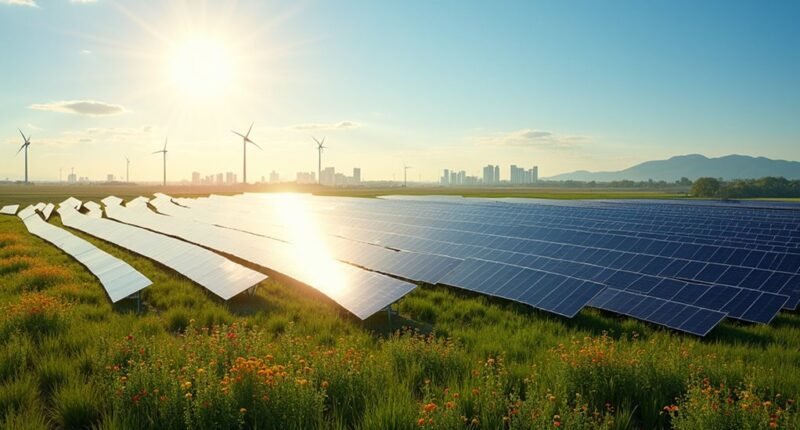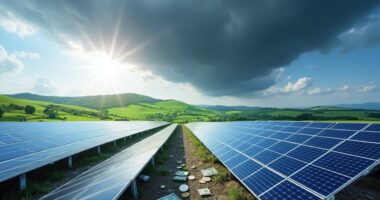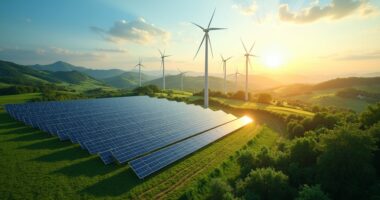Facebook, Amazon, and Equinix have made a splash by achieving 100% renewable electricity for their global operations, showcasing a strong commitment to their net-zero goals by 2025. These corporate giants are investing heavily in solar megaprojects, which are basically large-scale solar energy installations—think of them as solar panels on steroids. This eco-friendly shift not only benefits individual companies but also contributes to a greener supply chain. Curious about the challenges they face on this sustainable journey?
Quick Overview
- Facebook, Amazon, and Equinix have achieved 100% renewable electricity across their global operations, aligning with the RE100 initiative.
- The RE100 initiative has reached 421 members aiming for 100% renewable energy by 2025, promoting corporate climate goals.
- Companies are investing in solar megaprojects and power purchase agreements to decarbonize their supply chains.
- Strategic capital allocation and blended finance models support renewable energy projects in emerging markets like India and Brazil.
- Collaborative efforts across industries are essential to overcome regulatory hurdles and achieve sustainability targets amid financial pressures.
Achievements in Renewable Energy Adoption
In a remarkable feat that could make even Mother Nature smile, Facebook, Amazon, and Equinix proudly announced their achievement of 100% renewable electricity adoption across their global operations.
This milestone is part of the RE100 initiative, where companies commit to using only renewable energy. Thomas L. Keefe, Partner at Deloitte & Touche LLP, has noted that by late 2023, the initiative boasted 421 members, with many aiming for 100% renewables by 2025. The focus on technologies allowing the U.S. to generate all electricity from clean sources has driven companies like these to employ on-site generation and power purchase agreements, ensuring that their green goals extend beyond just themselves, supporting supply chain decarbonization.
These corporations have recognized the numerous environmental advantages of transitioning to renewable energy sources like solar, wind, and hydropower.
It’s like a corporate team effort to save the planet—everyone’s in it together, and the stakes are high!
Investment Strategies in Solar and Wind Projects
Strategic capital allocation is key. Leveraging concessional finance tools can transform overwhelming expenses into manageable investments, lowering electricity costs. Blended finance models mix public and private funds, accelerating projects in emerging markets like India and Brazil. Multilateral development banks can play a crucial role by providing risk mitigation instruments that attract private investors to climate projects. Companies should also explore hybrid solar-wind setups, which optimize land use and output stability. With offshore wind gaining traction, especially on the US East Coast, diversifying investments across technologies and geographies guarantees stronger returns—because who wouldn’t want to ride the renewable energy wave while saving the planet? Green energy sources deliver operational cost savings and enhance brand reputations, making them an attractive option for forward-thinking companies. Additionally, recent trends show that domestic battery manufacturing capacity is exceeding 2024 deployment, underscoring the importance of investing in complementary technologies to support renewable energy initiatives.
Challenges and Future Outlook for Sustainability Goals
Traversing the landscape of sustainability goals today feels akin to trying to assemble IKEA furniture without the manual—confusing and filled with unexpected twists.
Regulatory hurdles have companies scrambling, with 80% adjusting their strategies amid shifting climate policies. Collaboration across industries is becoming essential as firms navigate these changes, ensuring they address intertwined challenges effectively.
Meanwhile, financial pressures often push eco-friendly initiatives aside, leaving many behind on their sustainability targets. Over half of companies behind on supply chain goals reflects the struggles many face in meeting these objectives.
As stakeholders demand transparency, organizations are forced to share compelling narratives rather than vague ESG statements. Supply chain resilience has become a critical priority for companies facing both climate-related disruptions and geopolitical trade shifts.
The future remains uncertain; missed targets could lead to severe consequences.
Yet, in the chaos, innovative solutions and circular models promise competitiveness, steering companies toward a greener horizon—if they can navigate the maze.









